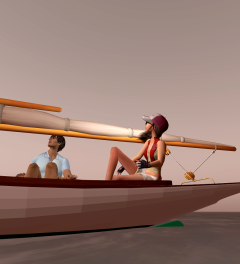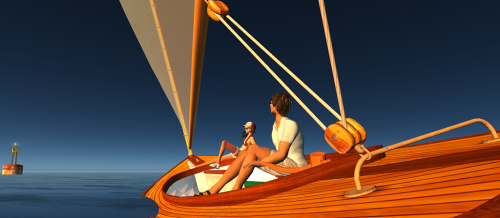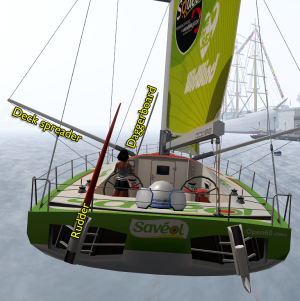2013 Second Sol Regatta
A Sail4Life Race Event
June 14-23, 2013
THE RACES
There will be two rounds of Qualifying Races. Round One will be held on June 15, and Round Two will be held on June 22.
The full competition fleet will be divided into timeslot groups for the qualifying races. If there are 16 boats, there will be four timeslots; if there are 20 boats there will be five (Four boats in each group). Each race team will be assigned to the same timeslot for both rounds. The winner of each timeslot group will advance to a Finals series on June 23.
Timeslot Races:
Each timeslot race will consist of four heats on a short course that should take 8-12 minutes to complete. The races will be hosted by several different clubs and marine estates in Second Life. The race course and wind settings will be determined by the host Race Director. These will be posted several days in advance of the qualifying rounds.
Finals Event:
The winners of the timeslot group qualifying races will all advanced to a Finals series that would be held in North sea on June 23. The details of the finals event will be announced separately.
THE BOAT
Teams will race a pre-release version of the Trudeau Patchogue II.
The boats will have individual Race ID numbers printed on the sails, so please use that number as your “Race ID,” and do not alter the sail textures.
The Race ID is not your Channel number. You may use any channel number you prefer (including your Race ID)
Some specific details:
— Simple landmark setters (such as TRAPNAV) that show race mark locations as ‘world map teleport points,’ are allowed. Anything more complicated that shows boat position or gives additional numerical data is not allowed.
— The use of simple ‘stop-watch’ timers is allowed.
SAIL TEAMS
Boats competing in the regatta will be registered to a “sailing team” that includes one or more people (yes, one person can be a ‘Team.”).
For any particular race, the boat’s team will decide which team members should crew, and which will skipper. (The minimum number aboard a race boat is a solo skipper; the maximum number is one skipper plus three crew).
Even in the middle of a race, a team can decide to add or remove crew, or switch skippers.
The number of crew aboard any boat at the START can be different from the number of crew crossing the FINISH line.
A sailor can be a skipper in only one timeslot on June 15 and 22, but any sailor can crew for any team in timeslots where they are not the skipper. (In other words, a sailor can skipper in the 9:00 timeslot but still crew for other teams in the 12:00 and 18:00 timeslots).
Each competing race boat must use a unique ID pre-printed on the boat’s sails and registered to the boat’s team. That ID should be loaded into the boat by the team so the boat will trigger the raceline.
All competing boats will use the Race Wind provided by the Start line windsetter (WWC Cruise Wind).
CRASHES
If a skipper crashes during a race, another team member can take the helm and continue sailing. The owner can also rez a new boat if needed. However, the new boat should rez at the nearest point to the crash site. The judges may call a penalty if they rule the new rez site is inappropriately far ahead of the crash.
PHANTOM OBSTRUCTIONS
A collision only occurs when a non-phantom part of the boat strikes another non-phantom object. The Patchogue II has phantom sails, but the mast and boom are physical.
SCORING
The Qualifying Timeslot Races will use the ISAF Appendix A Standard Low Point scoring system. Four races will be held in each timeslot on June 15, and the timeslots will be repeated on June 22. That gives each team the opportunity to race a total eight qualifying heats. NOTE: Teams will get four discards.
The final score will be determined by adding the best four results for each boat (after eliminating the four discards).
ISAF Appendix A 8.1 and 8.2 will be used to resolve any ties.
The boats with the lowest scores in each timeslot will then advance to the Finals Round. (Please note: If there are only four qualifying timeslots, and the results show one timeslot where two boats have an identical score, the Race Committee may decide to advance both tied boats to the Finals).
RULES AND REGS
ISAF Rules
The ISAF Race Rules will apply unless otherwise noted.
Please help us make sure the ‘rules’ are understood by all, and the judging and protest review is uniform, valid, and consistent.
Additional Rules Specific for Second Sol. 🙂
Note: Rule exceptions and SL-specific additions will be listed in the SECOND SOL thread on SLSailing.net and also published in-world.
Judges will use a two boat-length zone to resolve Rule 18 protests over ROW at racemarks. Rule 18 does not apply at start line marks, but will apply at the marks that define a GATE, except as stated in Rule 18.4.
Rule 30.1 will be enforced:
“…(if) any part of a boat’s hull, crew or equipment is on the course side of the starting line or one of its extensions during the last minute before her starting signal, she shall thereafter sail from the course side across an extension to the prestart side before starting.”
Rule 31 will also be enforced:
“31 TOUCHING A MARK While racing, a boat shall not touch a starting mark before starting, a mark that begins, bounds or ends the leg of the course on which she is sailing, or a finishing mark after finishing.”
JUDGING GUIDELINES:
SPORTSMANSHIP
Sportsmanship is a fundamental rule of sailing. the race committee will work hard to ensure a fair and orderly competition. Please follow the general guidelines below to register and resolve protests during the competition in a way that that respects the skill and pride of the many sailors participating in this event.
Please note: it is not appropriate for any racer to argue with the crew of another boat or argue with the Regatta staff except as outlined below. Any sailor who use defamatory language toward other sailors or makes inappropriate derogatory comments about the judging decisions will be given a warning. Any member of the race staff has the right to issue such a warning.
If a team receives a warning during a particular heat but continues to act inappropriately, then the judges can vote at any time to DSQ the boat from that particular heat for “unsportsmanlike conduct.” If a team continues to act inappropriately following such a DSQ, the judges can vote to DSQ that team from the entire regatta.
As discussed in more detail below, any team has the right to appeal a protest decision if they think the decision is in error under the RRS. They can also appeal a DSQ for unsportsmanlike conduct, but they must do so in an appropriate manner that is respectful of the sport of sailing and their fellow sailors.
PROTESTS
As soon as practical after an event occurs, the protesting boat should shout “PROTEST XXX” in open chat, where XXX is the name of the offending boat. The protestor should also announce it over the SECOND SOL Group Chat (or SLSA Group Chat if the other fails) to ensure the protest was heard. A Race Judge will acknowledge receipt of the protest.
An offending boat that accepts a protest from another boat or Judge shall acknowledge the acceptance of the foul by sailing clear of other boats and doing one 360 degree circle turn (two gybes) as soon as reasonably possible, and clear of the competition fleet.
A boat who does not accept a protest can settle the protest following the race with a protest hearing.
In either case, the crew of the protested boat must reply to the protest by shouting Accept or Deny in local chat and over the Group Chat channel as soon as practical after the protest is made.
At the conclusion of a race the RD and the #1 Judge should be the first people to speak to the finished boats once they are collected at the raceline. The staff may use local chat or group chat, whichever is most appropriate. The #1 Judge should ask: “Is there any protest?” and each skipper should reply “YES” or “NO.” If any skipper says YES, the #1 Judge is the ONLY race officer who should speak to the involved race teams about the protested event until that matter is resolved.
The #1 judge should collect standard information (in public chat or group channel) from the boat making the protest (“What protest? What Rule? Against which boat? What Circumstances?“). The #1 judge will then get the alleged offending boat’s response to the protest claim (again in public chat).
Please note: One sailor aboard the boat, preferably the skipper, should speak for each boat.
The Judges and umpires (and any others they chose to involve) then confer in private.
If the Protest Committee is in full agreement regarding a protest and penalty, the #1 judge will then announce the decision to the sailors and the observers in public chat. (For example: “Protest by Team Fossett sailing 82JF is DENIED. NO PENALTY.”)
The judge should then immediately go on to consider the next Protest or shout “NEXT RACE!” and turn management back over to the Race Director.
If a team thinks the Protest Committee made an error, the team should ask for an APPEAL. If the Protest Committee itself fails to reach a unanimous decision, they too should ask for an APPEAL.
The regatta should then continue, and the Appeals Judge(s) will render a final decision at the end of that qualifying timeslot series.
The Appeals Judge(s) will be the members of the Race Committee who were present for the race in question. They may involve other members of the Timeslot Race staff (such as the RD) in their discussions.































































